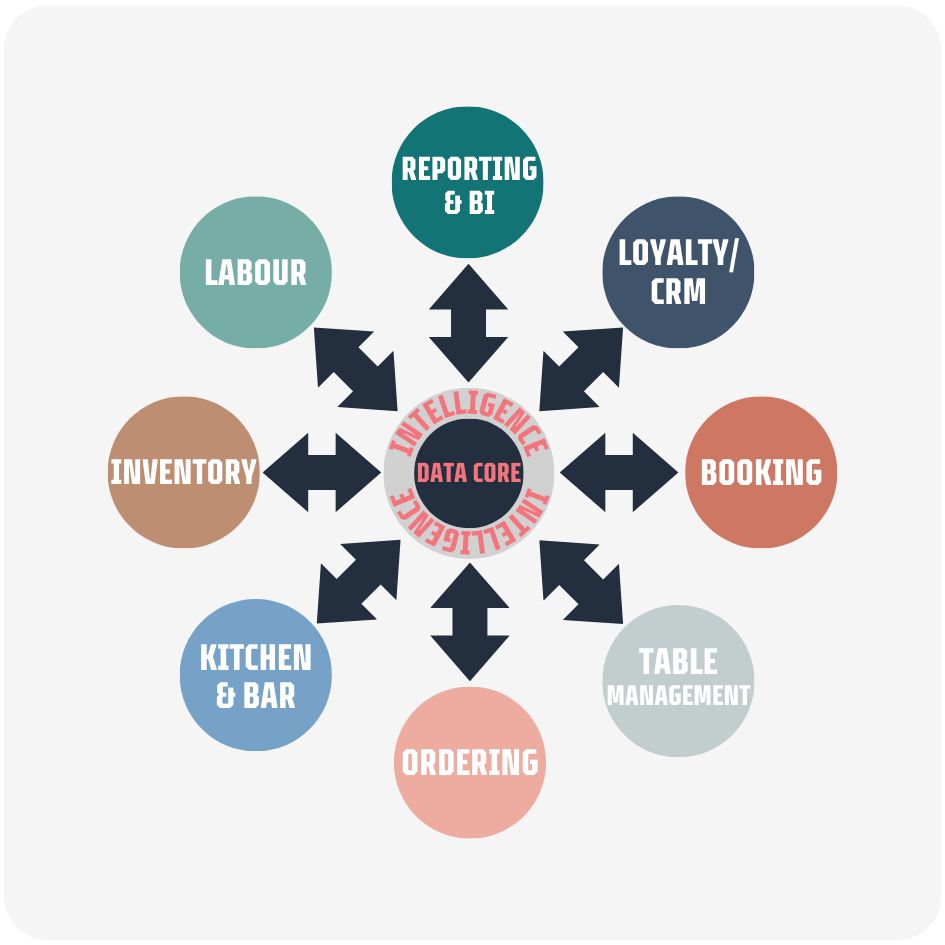Using data to create experiences worth repeating
The restaurant sector is always going through constant change.
To be able to succeed in this kind of environment, businesses need to be able to stay on their toes and adapt quickly with targeted, measured changes.
So how do we do this?
Technology is used throughout the hospitality industry with systems that improve operations and simplify and speed up many jobs.
But are all these systems working together?
Do they create the best experiences possible for customers, team and management?
It is no longer good enough to have a myriad of systems working independently only offering their own insights. To truly drive business forward and navigate the constantly changing markets, they need to work harder and faster.
Some of the touchpoints and systems involved are:
- CRM
- Booking systems
- Ordering platforms
- POS
- Kitchen management
- Labour management
- Payment systems
- Performance tracking
- Financial reporting
- Inventory management
And there are more. This is an example of just how many systems restaurants have to deal with at a time and all these systems mean A LOT of data.
Traditionally, each system will present the data that others need, and those other systems will fetch the data and use it. Sometimes this is done by the system itself and sometimes by middleware, with a basic one-way transfer of the data. This often means many interfaces coming and going from each system.

Restaurants need connectivity across their systems – a ‘joined-upness’ to allow for fast adaptation and flexibility, rather than a ‘just get what you need from where you need it' approach which is slow and fixed.
Having a central data core allows for all data from all systems to be pulled in, making it available across the different restaurant systems. This not only simplifies the number of data interfaces involved, it also gives a single place where all the business information is efficiently stored and allows the kind of holistic view of the data needed.
Then, by wrapping an intelligence layer around it, we can start to open up real-time analysis and really get into experience shaping, by allowing fast feedback and monitoring of the performance of any changes. That way, we can quickly decide if we keep the change, reverse it, tweak it, or simply do more of it. This makes change less of a risk and more of a dynamic process.
It's not just the small, incremental changes that this infrastructure encourages. It will also lessen the disruption and integration time of large system changes because changing any one part of the infrastructure only requires one point of integration, rather than several.
Faster changes - customer ordering example.
Rather than having an all out change in a number of restaurants, a couple of journey options could be created, tested and compared. If one or both new journeys have the desired effect then they can increase the number of guests who experience the new journey. If it's not working as well as hoped then the testing can be less frequent or stopped altogether. This reduces the risk of big impact on the business whilst giving a measured and calculated approach to change.
This kind of analysis does not need to stop at simply introducing change safely. The monitoring may show that one route is more effective at a time of day and the second at others, insights that would have probably never been found with traditional change process.
Joining up the data to enhance teams' experiences.
Using the joined-up data can ensure that schedules are created in a way that suggests the correct staff levels tailored to the experience customers want. For example, if a larger proportion of customers are ordering and paying on mobile devices at lunch time but that proportion changes in the evening, then looking at the covers, turnaround and sales figures may indicate that the staff levels should be higher in the fast turnaround lunch times. But when you add in the full picture, it is clear that actually we need fewer staff then, and more later on when the customer experience desires more human interaction. Shifting the staffing levels will give the experience the customers want, increasing return rates. It will also ensure staff are not too stretched and they will benefit from increased tips from happy customers. This insight would not be possible without the view of the business available to the data-centric infrastructure.
As well as scheduling, combining the data from multiple systems can highlight potential candidates for extra training, both to bring up standards and for possible promotions, plus ensuring that any good reviews can be turned into direct recognition for the relevant team members. This all leads to good experiences for the team.
So how do we implement a connected systems infrastructure?
The first and major step is creating the data-centric architecture and intelligence layer.
An infrastructure like this is designed to have all the elements you currently have connected to it. This means that it can be incorporated into any existing array of systems, in many cases without having to change the existing set-up other than where they collect data. It can also be done at the pace set by you, incorporating the elements that will give the quickest returns first.
Once that is in place, and combining all the business data to provide insight, the systems attaching to it can be adapted or swapped out to benefit from the full functionality of the change, monitor and adjust loops. This, again, can be done at a pace dictated by the restaurants without any of the 'big bang' change issues that are a synonymous with big system changes. Thus, cutting down on the impact and simplifying any team training required.
XMS fully integrates with any existing system your restaurant has; however, using XMS modules will optimise functionality.
